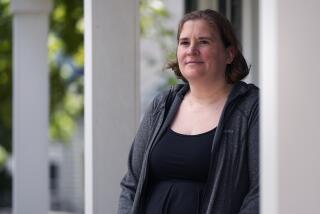Bank Fees Rise as Service Falls, New Survey Says
- Share via
Consumers paid more for banking services and got less in return during the past year, according to a new national survey by a coalition of consumer groups.
Monthly fees and per-check charges for interest-bearing checking accounts rose 9.9% in the 12 months ending in April, about the same as increases in the previous three years, the survey found.
During the same period, the survey found, interest paid to consumers on checking and savings accounts dropped and people had to pay more for loans.
The survey was conducted by the Consumer Federation of America, a Washington-based coalition of more than 220 organizations representing consumers, senior citizens and labor. The organizations examined 110 banks and 84 thrifts in the District of Columbia and 15 states, including California.
Higher Fees
Checking accounts with small balances are often money losers for institutions because of the costs of processing the accounts, so banks and thrifts frequently pass on the costs to consumers through monthly service fees and charges for writing checks or for using automated teller machines.
For instance, the survey found that people with small balances and moderate activity in their accounts are paying 56% higher fees for non-interest-bearing checking accounts than they did in 1984.
Consumer organizations have pressured banks for several years to offer low-cost checking accounts for low-income people, but the survey found that these so-called basic accounts are not available widely. Just over 20% of the institutions surveyed offered checking accounts with monthly charges of $3 or less.
The survey also said such low-cost accounts, which do not pay interest, were most prevalent at small savings and loan institutions and in small towns.
Those findings conflicted with a report issued last week by the American Bankers Assn., the biggest industry organization. The ABA said basic accounts were available at 52% of all banks and nearly 70% of the nation’s big banks, which are concentrated in urban areas.
Part of the discrepancy is apparently the result of definition. The consumer groups have set guidelines--$3 a month in fees and at least eight free checks--for basic accounts. The ABA simply asked banks if they offered low-cost accounts.
Also, the ABA findings were based on voluntary questionnaires, which the consumer groups said led to a heavier response from banks that have low-cost accounts.
The California Bankers Assn. on Tuesday released the results of a survey that covered banks with 75% of the state’s deposits and found that three-quarters of the institutions offered a low-cost checking account. The organization defined low-cost as an account with a monthly fee of $4.50 or less and a minimum balance requirement of $100.
Robert W. Moyer, chief executive of a small bank in Oneonta, N.Y., and chairman of the ABA’s consumer issues task force, said more banks are offering low-cost services even if they are money losers.
Variable Rates Fall
“It’s good for the community and it’s good for banking,” Moyer said. “But there is some resistance from bankers who say, ‘Why should I give away something free when everything else is costing me more?’ ”
One method used by banks and thrifts to control costs is variable rates for interest-bearing checking accounts and savings accounts, a practice that has been criticized as deceptive by consumer organizations.
Ken McEldowney, director of Consumer Action, a San Francisco organization that participated in the survey, said people assume that a variable rate on a checking or savings account is the same as an adjustable-rate home mortgage, in which the interest rises or falls on the basis of an independent index.
But he said variable-rate accounts are not tied to any outside factors and are raised or lowered arbitrarily by the banks and thrifts.
THE COST OF INTEREST-BEARING CHECKING
These are results of the Consumer Federation of America’s annual survey of the largest banks and S&Ls; in California. The study was conducted April 4-8 by Consumer Action and California Public Interest Research Group. Key: md, minimum daily balance; am , average monthly balance; C , check; M , monthly; ATM, automated teller machine; APR, annual percentage rate on balances of $999.
Example: Customers at California First earn 4% on their interest-bearing checking accounts. If they keep a minimum daily balance of $1,250 (or a $2,500 average monthly balance), they pay no fees. Otherwise, they pay $5 a month plus 35 cents per check. If they don’t want canceled checks returned, their fee is $4 a month plus 35 cents per check. (Some banks also charge for each use of an automatic teller machine. Security Pacific, for instance, charges $5 a month plus 40 cents per check or use of ATM.)
Min. Balance Institutions to Avoid Fee Service Fees APR Banks Bank of America $2,500 md $8M (1a) 4.00% California First $1,250 md (2c) $5M + 35 C (1b) 4.00% First Interstate $2,000 md (2a) $8M 4.00% Security Pacific $1,500 md $5M + 40 C/ATM 4.00% Union $2,500 am $6M 4.03% Wells Fargo $1,500 md $5M + 30 C/ATM (4) Savings and Loans American $500 md $5M 5.25% California Federal $800 md $6M 5.00% First Nationwide $1,000 md $6M 4.78% Gibraltar $750 md (2b) $6M (3) 4.75% Glendale Federal $1,000 md $8M 4.75% Great Western $1,000 md $6M 4.75% Home Federal $1,000 md $5M 5.00% Home Savings $750 md $6M 4.75% World $1,000 md $6M 4.76%
(1) If bank does not send back canceled checks: (a) $7M; (b) $4M + 35.
(2) Average balances of: (a) $3,000 am, (b) $2,000 am, (c) $2,500 am.
(3) Monthly discount of $2 when customer uses only ATM or checks.
(4) No interest earned on balances under $1,500.
More to Read
Inside the business of entertainment
The Wide Shot brings you news, analysis and insights on everything from streaming wars to production — and what it all means for the future.
You may occasionally receive promotional content from the Los Angeles Times.










